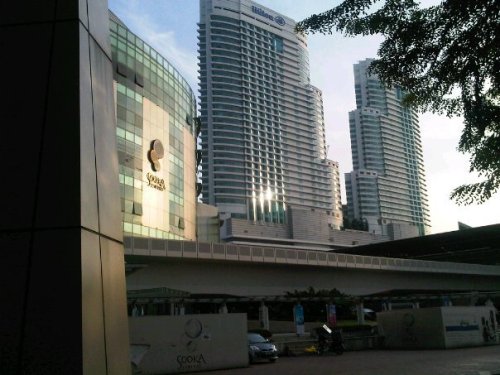As Adam and I hailed a cab that would take us to the Bangsar LRT station, I promised myself that I would never pay another RM6.60 (US$2.20) for that leg of my commute. I resolved to learn the bus.

I arrived at Plaza Sentral at 8:00AM, so I had to wait for 30 minutes for the actual office to open. As soon as it did, I greeted Sean and got straight to work…on learning the bus route. I discovered that KL has 4 different types of trains (LRT, commuter rail, monorail, and a direct line to the airport), about 5 different city bus companies. By 8:59AM, I figured out which company I needed, but it was time to start work.
At about 9:15AM, I realized that Sean and I were the only 2 in the office. By 9:30ish and 9:45AM others trickled in. I wonder if this is because the CEO is out of town. We’ll see on Wednesday.

(From the office window. Luxury Condo in the foreground, Brickfields—Little India—in the background)
With a fresh pair of eyes and renewed pride that I was working at a fancy consulting firm in a real office building, I began to comb through MMC Corporation’s 2010 Annual Report in search of indicators to rate how socially responsible this giant infrastructure, transportation, construction logistics, and engineering companyinvested.
Although the electronic rating form consists of many boxes to tick (check, as we say), I became pretty nervous and began to second-guess myself. After all, this was a company that grossed RM8.6billion (US$2.95) in 2010. I didn’t want to mess anything up. I asked another analyst if the company deserved credit for disclosing that the company reviewed the size of the board and feels that it is appropriate. It was “heavily implied in the report since it said that it was the board’s job to determine this each year. If there were no changes—”
“Was it officially disclosed?”
“Not officially…”
“Then no tick.”
Later that afternoon, I received a contradictory answer to a similar question. This goes to show that even the most objective-looking rating tool is still vulnerable to human interpretation, biases, and inconsistencies.
At lunch, I chatted with the guys about socially-conscious rap (including the vile rapper, Common), bounce music, and second-lining. They shared that most young Malaysians listen to pop from Hong Kong and the West. The local music is folk music—not very popular for teens and twenty-somethings.
After establishing a modest rhythm on the ratings, and 6PM hit, I resumed search for the bus that would take me to the promised land. By 6:20, Andre was the only other person in the office. He took another 15 minutes, himself, helping me find which bus to take.
When I arrived at the Bangsar LRT station, I asked 4 different people where to find the T634 bus, and got 4 different answers. I then remembered my intercultural training. “Very few people there will admit that they do not know where something is (or fully understand your English), they’ll just point.” It got awkward when I had to stand right next to the first guy (of 4) who gave me the wrong directions. We were probably both embarrassed as we made no eye contact and I boarded the T634 bus. Though elated, I could not allow the Bollywood movie blaring on the screen to distract me. I still had to press that little red button right before my stop, or end up in Thailand or something.

As I stepped off of the bus at the correct stop, I strutted into the sunset in a self-congratulatory mood. I reduced my daily commute from RM15.20 (US$5.03) to RM3.60 (US$1.19)!






